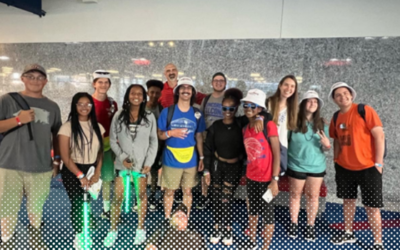Sometimes it’s difficult to connect with students face to face. Time, distance or times of disaster might mean that you must use other tools to connect. Video meetings are a great tool to help build those relationships. You can use any number of platforms from Google Meet Ups to Skype to Zoom. Whatever you use, here are ten tips for how to make the most of these meetings.
-
Pray and share God’s Word!
This is the most important part of any small group. We are gathering around the good news of the Gospel. God’s Word is living and active, even across technology. Be sure to make that the center, not an add on, of your time with your young people.
-
Be sure to start the room early and be ready.
Even young people can get antsy with waiting and technology. Often if they are ready early, they will join your video chat ahead of the start time. If they sign on and don’t see anyone, it can add to the stress of a new platform. It’s helpful to be ready and on 10 minutes early, even if you just leave up a sign in front of your camera that says “Welcome, we will start in just a minute!”
-
Welcome people as they join the meeting and start with icebreakers that make sure everyone is talking in the first few minutes.
As people sign on, greet them. This gives them a chance to make sure they can hear and see you and you can hear and see them. It’s also helpful to start the time with an icebreaker that gets everyone interacting right away. The sooner they get over any nerves or tech issues, the smoother the rest of your time will be.
-
Remember that your young people aren’t just digital. They are in a real space.
You can encourage young people to find a comfortable, quiet space so they can hear and be heard. Get them up and moving with a dance party or interactive game. You can even let them show and tell the snacks they have. Just like face to face meetings, you want them to be relaxed and engaged in their space.
-
Invite young people to help and lead.
This is a great chance to engage new young people for leadership. You might have someone pick out a funny video or meme to share. You could have someone lead a breakout group (available with Zoom) or help ask discussion questions. One of the nice things about video chats is that a student doesn’t have to be up front to lead like they do in face to face interactions. They can also have a script in front of them and people won’t know. Consider what young people might benefit from a chance to lead this way.
-
Lean into the awkwardness. This isn’t a business meeting.
Someone’s cat is going to jump in front of their screen. Or they are going to drop their phone. Or their mom is going to yell from the other room after totally forgetting they are on your video chat. Enjoy those moments, rather than frowning on them. If you bring levity and ease to the group, it will help discussion flow despite the different format.
-
Get creative with games that can be modified to be played over video chat.
You can play more games on video chat than you think. Go through your game collection and you will likely find games that work for this format. If you are using Zoom, you can use the shared screen and whiteboard features for games as well.
-
Use tools like breakout groups or polls for interaction.
Most video chat software have features that help facilitate interaction. If you are leading a Bible study, have students share questions in the chat. Some have polling features where you can ask questions for the group to respond. Others have features that allow you do to breakouts and pair shares. The better you know your software, the more creative you can get with the interactions.
-
Unlike other small group settings, call on specific people to answer questions.
While we might use the rule that allows young people to pass during conversations in person, video chat sometimes needs you to call on specific people to get started. Without the ability to read non-verbal cues, young people can struggle to know when to jump in and speak. Calling on people specifically helps with that. It also helps to designate who is going to pray or give specific prayer requests to specific people, rather than an open-ended popcorn prayer.
-
Follow up with texts, emails, and other messages.
Usually face to face meetings have time afterwards where people linger and talk. This is often when young people will share updates with leaders more one-on-one. In order not to lose that, be sure to follow up with prayers, Bible verses, encouragements and thoughts via other means after the meeting. Maybe you share something on social media, or in a group text. Reaching out a second time can encourage young people to stay engaged after the meeting is over.
If we are sharing the good news of Jesus and building up one another in the faith, our meetings are successful. Don’t put too much pressure on video meetings to meet all your ministry needs. Instead, use them as a way to be a light, caring for one another in Jesus’ name even when we cannot be physically together.











0 Comments